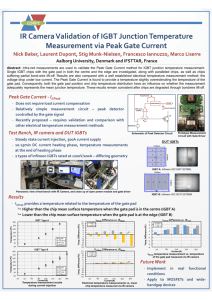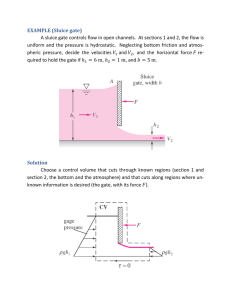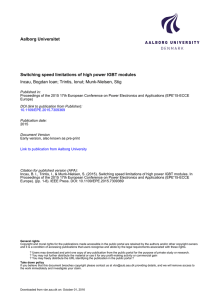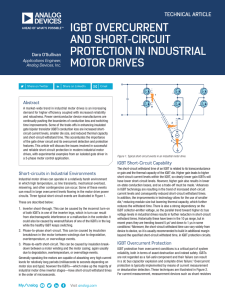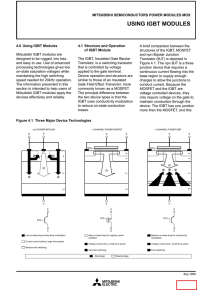Presentation: Error Control Coding
advertisement
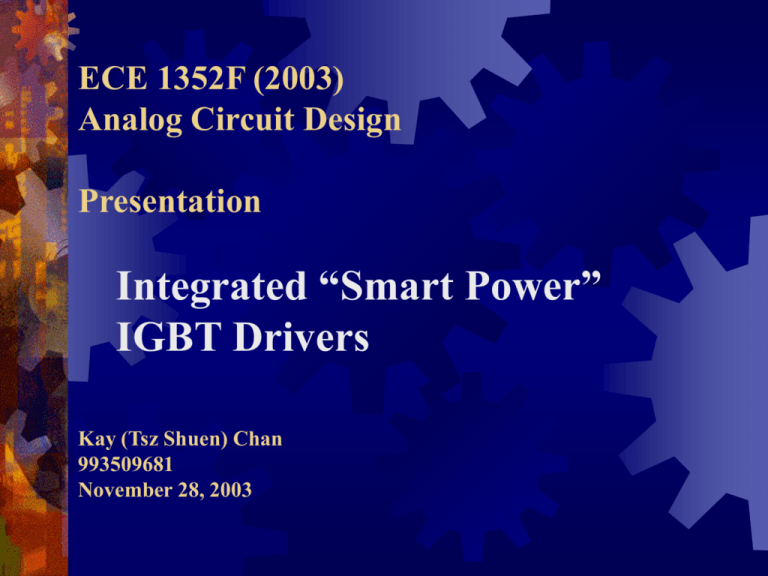
ECE 1352F (2003) Analog Circuit Design Presentation Integrated “Smart Power” IGBT Drivers Kay (Tsz Shuen) Chan 993509681 November 28, 2003 Objectives Introduce briefly some of the design considerations of IGBT drivers in power electronics Present recent design techniques and circuits for IGBT driver Address design future challenges in IGBT driver “Smart Power” IC Electrical Energy Source Discrete Power Converter (Switches) Electrical Load Functions: - control logic - protection - diagnostic feedback - power output stage - etc … “Smart Power” IC, or PIC: all functions in a power converter are integrated onto a single IC chip Process: GTO, Power BJT, Power MOSFET, IGBT, BCD (Bipolar, CMOS, and DMOS) “Smart Power” IC Design goals: Manage voltage and current of the device within the rating levels Minimize power dissipation Use as few parts as possible Applications: Electric power transmission UPS power supplies Switchmode power supplies Automotive Motor Control Household appliances IGBT IGBT = Insulated Gate Bipolar Transistor Combine of BJT and MOS in Darlington configuration Gate drive (voltage drive) IGBT: Switches in PIC Compared to BJT and Power-MOS, IGBT has Higher on-state voltage and current density Higher input impedance Rapid switching times Lower conduction losses Less silicon area because the gate driver circuit is simpler Becomes a popular switching device in medium and high power applications (>100W) To increase voltage rating (>1000V), need to use series-connected IGBTs IGBT: Switching Characteristics Switching losses Overvoltage (VCE,overvoltage) Overcurrent (IRR) IGBT: Switching Losses Energy dissipation over a period: To minimize loss -> faster turn-on and turn-off For faster turn-on –> increase gate drive voltage –> decrease series gate resistance For faster turn-off –> reduce tailing current –> short minority carrier lifetime Edissipate iC (t ) VCE (t )dt IGBT: Safe Operating Area Current and voltage boundary within which the IGBT can be operated without destructive failure Long duration of simultaneous high voltage and current across IGBT leads to thermal breakdown –> Reduce overcurrent and overvoltage di I RR 2 I 0 dt on di VCE ,overvoltage LS dt off –> Imply slower turn-on and turn off!! Trade-off between speed (switching losses) and overshoot voltage (circuit reliability) Gate Driver Design Techniques Reduce IRR (diode reverse recovery current) by: reducing di/dt, which means increasing gate series resistances Reduce VCE,overvoltage by reducing di/dt balancing gate timing and voltage sharing among the series-connected IGBTs In both cases, need a better, independent control of di/dt and dv/dt to optimize the gate driver for speed, minimum losses, and reliability Two-Stage Gate Driver To reduce IRR and VCE,overvoltage , [6] suggested the following two-stage driver circuit Turn-on: RGon2 << RGon1 Stage-2 is off initially Cgate charged through RGon1 (larger) to keep IRR small After diode has recovered, stage-2 turn on (triggered by VREF in comparator) Driver resistance is now RGon1||RGon2 (smaller) Two-Stage Gate Driver Turn-off: RGoff2 << RGoff1 Stage-1 & 2 is on initially for rapid discharge of Cgate (RGoff1||RGoff2 smaller) When VCE has risen to DC, link voltage, stage-2 turns off Driver resistance is RGoff1, reducing current fall rate After VCE is settled, stage-2 turns on again to ensure small driver impedance and prevent against dv/dt induced turn-on Two-Stage Gate Driver Experiment Results: turn-off switching loss reduced by 28.8%; turn-off delay reduced significantly compared to just increasing gate resistance DC link voltage = 100V at 8 kHz Load current = 15A Active Gate Control [5] suggested an active, independent dv/dt and di/dt control techniques by means of feedback (Miller effect) dv/dt control: Add Miller capacitance connecting gate and collector Add, at gate node, a dependent current source whose current is proportional to capacitor current Net current at gate node is Im(1-A). By adjusting A, can change the total capacitance across gate and collector, and thus changing dv/dt Active Gate Control dv/dt control: dVCE ,off dt Control circuits activates only when drain voltage is changing Control action begins as soon as collector voltage switching transient begins Adjustments of dv/dt is easy to accomplish IL VEE gm Rg Cgc 1 A CM VT dVCE ,on dt IL VCC gm Rg Cgc 1 A CM VT In the sample circuit, A is a linear function of Vc Active Gate Control Experimental Results: For both turn-on and turn-off dv/dt control circuits with a 1.5nF external Millar capacitor, dv/dt varies over a range exceeding 3:1 Operating conditions: Vdc = 600V VCC = 16V IC = 20A VEE = -5V LLoad = 1mH Rg = 40 Active Gate Control di/dt control: Dual version of dv/dt -> add external inductance LS connecting in series with switch emitter Experimental Results: Again, for both turn-on and turn-off di/dt control circuits with a 80nH external inductance, di/dt varies over a range exceeding 3:1 Voltage Balancing Different switching time of the IGBTs in series leads to imbalance of voltage share, resulting in overvoltage at turn-off Overvoltage can be reduced by matching the switching time and balancing the voltage share Voltage Balancing [7] suggested a multi-level clamp and turn-off timing adjustment driver to balance the voltage Overvoltage reduces from 3700V to 3300V Turn-off timings within 100ns Voltage Balancing [8] suggested another way of balancing the voltage by connecting a simple iron core and coils at the gate Future Challenges How to best utilize the control techniques in future generations of gate drive circuits In particular, how to optimize the gate drive circuits for a even better timing and switching losses while keeping the circuits compact As the voltage and current ratings increase, new techniques are in need to ensure circuit protection and reliability Future Challenges Recent IEEE papers have presented analysis of IGBT operation under short-circuit, over temperature, hard switching fault, and fault under load conditions (next step -> gate drive circuits realization) IGBT process has been evolving, leading to new concerns in gate driver design References ECE1352 Term Papers: [1] O. Trescases, “ECE1352 Term Paper: Integrated “Smart Power” IGBT Drivers”, 2003. IGBT Process: [2] M. H. Rashid, Power Electronics Handbook, San Diego: Academic Press, 2001. [3] N. Kularatna, Power Electronics Design Handbook: Low-Power Components and Applications, Boston: Newnes, 1998. IGBT Gate Drive: [4] R.S. Chokhawala, J. Catt, and B.R. Pelly, “Gate Drive Considerations for IGBT Modules,” Industry Applications, IEEE Transactions on, vol. 31, no. 3, pp. 603-611, May-June 1995. References IGBT Gate Drive: [5] S. Park and T. M. Jahns, “Flexible dv/dt and di/dt Control Method for Insulated Gate Power Switches,” Industry Applications Conference, 2001. 36th IAS Annual Meeting. Conference Record of the 2001 IEEE, vol. 2, pp. 1038-1045, Sept-Oct 2001. [6] R. Sachdeva and E. P. Nowicki, “A Novel Gate Driver Circuit for Snubberless, Low-Noise Operation of High Power IGBT,” Electrical and Computer Engineering, 2002. IEEE CCECE 2002. Canadian Conference, vol. 1, pp. 212-217, May 2002. [7] H. Nakatake and A. Iwata, “Series Connection of IGBTs used Multi-Level Clamp Circuit and Turn Off Timing Adjustment Circuit,” Power Electronics Specialist, 2003. PESC '03. IEEE 34th Annual Conference, vol. 4, pp. 19101915, June 2003. [8] K. Sasagawa, Y. Abe, and K. Matsuse, “Voltage Balancing Method for IGBTs Connected in Series,” Industry Applications Conference, 2002. 37th IAS Annual Meeting. Conference Record, vol. 4, pp. 2597-2602, Oct 2002.

